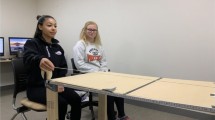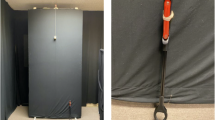Abstract
Perception of whether a given behavior is possible typically reflects a person’s action capabilities even before the behavior is performed and even when the person has undergone recent changes to their action capabilities. Importantly, perception of affordances for a given behavior also reflects impending changes to action capabilities. Two experiments investigated perception of affordances for reaching when the means of reaching would bring about changes in reaching ability. Experiment 1 found that perception of maximum reaching height is relative to impending changes brought on by a change in posture and use of a hand-held tool. Experiment 2 found that practice performing a reaching task in which reaching ability is unchanged is sufficient to bring about improvements in perception of maximum reaching height when the means of reaching would change reaching ability. The results are discussed in the context of the prospectivity of perception of affordances, and the experiences that may be necessary to bring about (transfer of) improvements in perception of affordances.


Similar content being viewed by others
Notes
The mean ratio in the pre-test of the no-reach (.88) is high compared the mean ratio in the post-test (.89). This is primarily due to the contribution of two participants in the no-reach condition. When these participants are removed, the mean is somewhat lower (.86) but there is no change in the pattern of the results.
The fact that the main effect of Test is accompanied by an interaction of Test × Expected Tool Use serves to rule of the possibility that post-test perceptual reports are merely pre-test perceptual reports plus a constant. If this were the case, there would be a main effect of Test but no interaction.
References
Adolph KE (1995) Psychophysical assessment of toddlers’ ability to cope with slopes. J Exp Psychol Hum Percept Perform 21:734–750. doi:10.1037/0096-1523.21.4.734
Adolph KE (2000) Specificity of learning: why infants fall over a veritable cliff. Psychol Sci 11:290–295. doi:10.1111/1467-9280.00258
Carello C, Grosofsky A, Reichel FD, Solomon HF, Turvey MT (1989) Visually perceiving what is reachable. Ecolo Psychol 1:27–54. doi:10.1207/s15326969eco0101_3
Chemero A (2003) An outline of a theory of affordances. Ecolo Psychol 15:181–195. doi:10.1207/S15326969ECO1502_5
Fajen BR (2008) Perceptual learning and the visual control of braking. Percept Psychophys 70:1117–1129. doi:10.3758/PP.70.6.1117
Fajen BR, Devany MC (2006) Learning to control collisions: the role of perceptual attunement and action boundaries. J Exp Psychol Hum Percept Perform 33:689–715. doi:10.1037/0096-1523.32.2.300
Franchak JM, van der Zalm DJ, Adolph KE (2010) Learning by doing: action facilitates affordance perception. Vision Res 50:2758–2765. doi:10.1016/j.visres.2010.09.019
Gibson JJ (1979) The ecological approach to visual perception. Houghton Mifflin, Boston
Higuchi T, Takada H, Matsuura Y, Imanaka K (2004) Visual estimation of spatial requirements for locomotion in novice wheelchair users. J Exp Psychol Appl 10:55–66. doi:10.1037/1076-898X.10.1.55
Higuchi T, Murai G, Kijima A, Seya Y, Wagman JB, Imanaka K (2011) Athletic experience influences shoulder rotations when running through apertures. Hum Mov Sci 30:534–549. doi:10.1016/j.humov.2010.08.003
Hirose N, Nishio A (2001) The process of adaptation to perceiving new action capabilities. Ecol Psychol 13:49–69. doi:10.1207/S15326969ECO1301_3
Ishak S, Adolph KE, Lin GC (2008) Perceiving affordances for fitting through apertures. J Exp Psychol Hum Percept Perform 34:1501–1514. doi:10.1037/a0011393
Konczak J, Meeuwsen HJ, Cress ME (1992) Changing affordances in stair climbing: the perception of maximum climbability in young and older adults. J Exp Psychol Hum Percept Perform 18:691–697. doi:10.1037/0096-1523.18.3.691
Mark LS (1987) Eyeheight-scaled information about affordances: a study of sitting and stair climbing. J Exp Psychol Hum Percept Perform 13:361–370. doi:10.1037/0096-1523.13.3.361
Mark LS, Balliett JA, Craver KD, Douglas SD, Fox T (1990) What an actor must do in order to perceive the affordance for sitting. Ecolo Psychol 2:325–366. doi:10.1207/s15326969eco0204_2
Mark LS, Nemeth K, Gardner D, Dainoff MJ, Paasche J, Duffy M, Grandt K (1997) Postural dynamics and the preferred critical boundary for visually guided reaching. J Exp Psychol Hum Percept Perform 23:1365–1379. doi:10.1037/0096-1523.23.5.1365
Pijpers JR, Oudejans RRD, Bakker FC (2007) Changes in the perception of action possibilities while climbing to fatigue on a climbing wall. J Sports Sci 25:97–110. doi:10.1080/02640410600630894
Ramenzoni V, Riley MA, Davis T, Shockley K, Armstrong R (2008) Tuning into another person’s action capabilities: perceiving maximal jumping-reach height from walking kinematics. J Exp Psychol Hum Percept Perform 34:919–928. doi:10.1037/0096-1523.34.4.919
Ramenzoni V, Davis TJ, Riley MA, Shockley K (2010) Perceiving action boundaries: learning effects in perceiving maximum jumping-reach affordances. Att Percept Psychophys 72:1110–1119. doi:10.3758/APP.72.4.1110
Stoffregen TA (2003a) Affordances are enough: reply to Chemero et al. (2003). Ecolo Psychol 15:29–36. doi:10.1207/S15326969ECO1501_03
Stoffregen TA (2003b) Affordances as properties of the animal-environment system. Ecolo Psychol 15:115–134. doi:10.1207/S15326969ECO1502_2
Stoffregen TA, Yang CM, Bardy BG (2005) Affordance judgments and nonlocomotor body movement. Ecolo Psychol 17:75–104. doi:10.1207/s15326969eco1702_2
Stoffregen TA, Yang CM, Giveans MR, Flanagan M, Bardy B (2009) Movement in the perception of an affordance for wheelchair locomotion. Ecolo Psychol 21:1–36. doi:10.1080/10407410802626001
Turvey MT (1992) Affordances and prospective control: an outline of the ontology. Ecolo Psychol 4:173–187. doi:10.1207/s15326969eco0403_3
Turvey MT (2004) Space (and its perception): the first and final frontier. Ecolo Psychol 16:25–29. doi:10.1207/s15326969eco1601_3
Wagman JB (2008) Perception-action as reciprocal, continuous, and prospective. Behav Brain Sci 31:219–220. doi:10.1017/S0140525X080040
Wagman JB, Malek EA (2007) Perception of whether an object can be carried through an aperture depends on anticipated speed. Exp Psychol 54:54–61. doi:10.1027/1618-3169.54.1.54
Wagman JB, Malek EA (2008) Perception of affordances for walking under a barrier from proximal and distal points of observation. Ecolo Psychol 20:65–83. doi:10.1080/10407410701766650
Wagman JB, Morgan LL (2010) Perceived maximum reaching height reflects anticipated changes in reaching ability. Psychonomic Bull Rev 17:905–909. doi:10.3758/PBR.17.6.905
Warren WH (1984) Perceiving affordances: visual guidance of stair climbing. J Exp Psychol Hum Percept Perform 10:683–703. doi:10.1037/0096-1523.10.5.683
Weast JA, Shockley K, Riley MA (2011) The influence of athletic experience and kinematic information on skill-relevant affordance perception. Q J Exp Psychol 64:689–706. doi:10.1080/17470218.2010.523474
Yu Y, Bardy BG, Stoffregen TA (2011) Influences of head and torso movement before and during affordances perception. J Mot Behav 43:45–54. doi:10.1080/00222895.2010.533213
Acknowledgments
During the writing of this manuscript, the author was supported, in part, by a Summer Faculty Fellowship from the College of Arts and Sciences at Illinois State University. I thank Lydia Morgan for help with data collection, Dawn McBride for helpful discussion, and two anonymous reviewers for comments on a previous draft of this manuscript.
Author information
Authors and Affiliations
Corresponding author
Rights and permissions
About this article
Cite this article
Wagman, J.B. Perception of maximum reaching height reflects impending changes in reaching ability and improvements transfer to unpracticed reaching tasks. Exp Brain Res 219, 467–476 (2012). https://doi.org/10.1007/s00221-012-3104-x
Received:
Accepted:
Published:
Issue Date:
DOI: https://doi.org/10.1007/s00221-012-3104-x




